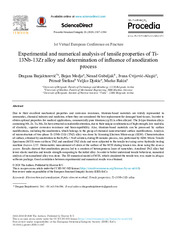Приказ основних података о документу
Experimental and numerical analysis of tensile properties of Ti-13Nb-13Zr alloy and determination of influence of anodization process
| dc.creator | Barjaktarević, Dragana | |
| dc.creator | Međo, Bojan | |
| dc.creator | Gubeljak, Nenad | |
| dc.creator | Cvijović-Alagić, Ivana | |
| dc.creator | Stefane, Primoz | |
| dc.creator | Đokić, Veljko | |
| dc.creator | Rakin, Marko | |
| dc.date.accessioned | 2022-03-04T11:13:56Z | |
| dc.date.available | 2022-03-04T11:13:56Z | |
| dc.date.issued | 2020 | |
| dc.identifier.issn | 2452-3216 | |
| dc.identifier.uri | http://TechnoRep.tmf.bg.ac.rs/handle/123456789/4751 | |
| dc.description.abstract | Due to their excellent mechanical properties and corrosion resistance, titanium-based materials are widely represented in aeronautics, chemical industry and medicine, where they are considered the best replacement for damaged hard tissues. In order to obtain optimal properties for medical applications, commercially pure titanium (cpTi) is often alloyed. The beta-type titanium alloys containing Nb, Zr, Ta, Mo, Sn have attracted considerable attention, due to their unique combinations of high strength, low modulus of elasticity, superior corrosion resistance and biocompatibility. Also, titanium-based materials can be processed by surface modifications, including the anodization, which belongs to the group of chemical nanostructured surface modifications. Analysis of microstructure of two-phase Ti-13Nb-13Zr (TNZ) alloy was done by Scanning Electron Microscopy (SEM). Characterisation of surface, obtained by anodization in the H3PO4 + NaF solution, during 90 minutes process, was performed by SEM. Micro Tensile Specimens (MTS) were cut from TNZ and anodized TNZ disks and were subjected to the tensile test using servo-hydraulic testing machine Instron 1255. Stereometric measurement of strain at the surface of the MTS during tension was done using the Aramis system. Results showed that anodization process led to a creation of heterogeneous layer of nanotubes. Anodized TNZ alloy had lower elastic modulus and tensile strength comparing to the initial alloy. In order to better understand tensile behaviour, numerical analysis of non-anodized alloy was done. The 3D numerical model of MTS, which simulated the tensile test, was made in Abaqus software package. Good correlation between experimental and numerical results was obtained. | en |
| dc.relation | info:eu-repo/grantAgreement/MESTD/inst-2020/200135/RS// | |
| dc.rights | openAccess | |
| dc.rights.uri | https://creativecommons.org/licenses/by-nc-nd/4.0/ | |
| dc.source | Procedia Structural Integrity | |
| dc.subject | Electrochemical anodization | en |
| dc.subject | Finite element method | en |
| dc.subject | Tensile properties | en |
| dc.subject | Ti-13Nb-13Zr alloy | en |
| dc.title | Experimental and numerical analysis of tensile properties of Ti-13Nb-13Zr alloy and determination of influence of anodization process | en |
| dc.type | conferenceObject | |
| dc.rights.license | BY-NC-ND | |
| dc.citation.epage | 2194 | |
| dc.citation.other | 28(): 2187-2194 | |
| dc.citation.spage | 2187 | |
| dc.citation.volume | 28 | |
| dc.description.other | 1st Virtual European Conference on Fracture | |
| dc.identifier.doi | 10.1016/j.prostr.2020.11.047 | |
| dc.identifier.fulltext | http://TechnoRep.tmf.bg.ac.rs/bitstream/id/7982/Experimental_and_numerical_analysis_pub_2020.pdf | |
| dc.identifier.scopus | 2-s2.0-85099809440 | |
| dc.identifier.wos | 000632387500249 | |
| dc.type.version | publishedVersion |

